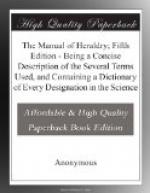Ex. A griffin rampant, segreant, gules.
SEJANT. French word for sitting. See LION SEJANT.
SEME. A French word for strewed. A field powdered or strewed with any object is said to be seme: thus a shield may be seme of fleur-de-lis, seme of hearts, &c.
SINISTER. A term used in Heraldry to signify the left side of any object. Thus a bend proceeding from the top of the left side of the shield is called a bend sinister.
SLIPPED. Torn from the stock or branch.
[Illustration: Slipped]
Ex. Azure, three laurel leaves slipped, argent.
SOL. A planet, formerly used to denote or, in
emblazoning royal arms.
It is the Latin name for the sun.
SOL, or THE SUN IN ITS SPLENDOUR. The sun is said to be in its splendour when it is figured (that is, delineated with a human face) and surrounded with rays. Sometimes this figure is called a sun in its glory.
[Illustration: Sol, or The Sun in its Splendour]
Ex. Azure, a sun in its splendour.
STANDARD. A large square flag bearing the whole of the achievements of the monarch or nobleman, as seen in the royal standard of England. The royal standard, when placed before the pavilion of the monarch either at a tournay or in an encampment, was eleven yards long and three yards broad.
The length of the standard when borne in the field denoted the rank of the leader: that of a duke was seven yards long; a peer of lower degree raised a standard five yards in length; that of a knight banneret was only four. In modern times standards of peers or knights banneret are seldom displayed but in funeral processions. The standard is then long and narrow, and pointed at the end; that of a duke is about fifteen feet in length, peers of lower degree about twelve.
The flag borne as the ensign of a regiment of cavalry is called a standard. The flags of foot soldiers are called colours.
STAR. This celestial figure is always represented as argent, and is supposed to have six rays or points; if they have more points the number must be named. See ETOILE.
STATANT. An animal standing still with all its legs on the ground. See LION STATANT.
SUPPORTERS are figures standing on the scroll, placed on each side of the shield as if to support it. Supporters in English Heraldry are granted only to persons included in the rank of nobility or to knights banneret by favour of the sovereign.
The origin of this addition to the external ornaments of the escutcheon may be traced to the practice which originally prevailed in the regulation of tournaments. Some days prior to the tournament taking place, each knight desirous of entering the lists was required to hang up his shield, upon which his arms were emblazoned, at the place appointed by the prince or nobleman that proclaimed the tournament, that they might be examined by the heralds, to prevent unqualified persons entering the lists. Each shield thus exhibited was guarded or supported by the servants of the knight to whom it belonged, and to disguise their livery these guardians of the shield assumed the appearance of savages, Moors, lions, griffins, and various other animals.




